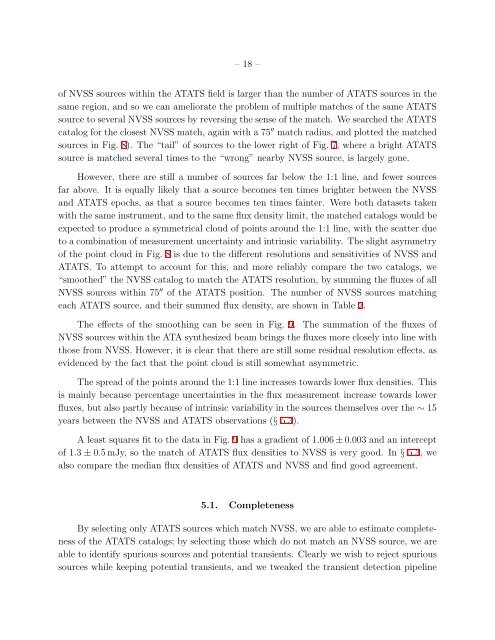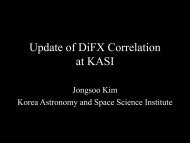The Allen Telescope Array Twenty-centimeter Survey—A - CIRA
The Allen Telescope Array Twenty-centimeter Survey—A - CIRA
The Allen Telescope Array Twenty-centimeter Survey—A - CIRA
Create successful ePaper yourself
Turn your PDF publications into a flip-book with our unique Google optimized e-Paper software.
– 18 –<br />
of NVSS sources within the ATATS field is larger than the number of ATATS sources in the<br />
same region, and so we can ameliorate the problem of multiple matches of the same ATATS<br />
source to several NVSS sources by reversing the sense of the match. We searched the ATATS<br />
catalog for the closest NVSS match, again with a 75 ′′ match radius, and plotted the matched<br />
sources in Fig. 8). <strong>The</strong> “tail” of sources to the lower right of Fig. 7, where a bright ATATS<br />
source is matched several times to the “wrong” nearby NVSS source, is largely gone.<br />
However, there are still a number of sources far below the 1:1 line, and fewer sources<br />
far above. It is equally likely that a source becomes ten times brighter between the NVSS<br />
and ATATS epochs, as that a source becomes ten times fainter. Were both datasets taken<br />
with the same instrument, and to the same flux density limit, the matched catalogs would be<br />
expected to produce a symmetrical cloud of points around the 1:1 line, with the scatter due<br />
to a combination of measurement uncertainty and intrinsic variability. <strong>The</strong> slight asymmetry<br />
of the point cloud in Fig. 8 is due to the different resolutions and sensitivities of NVSS and<br />
ATATS. To attempt to account for this, and more reliably compare the two catalogs, we<br />
“smoothed” the NVSS catalog to match the ATATS resolution, by summing the fluxes of all<br />
NVSS sources within 75 ′′ of the ATATS position. <strong>The</strong> number of NVSS sources matching<br />
each ATATS source, and their summed flux density, are shown in Table 2.<br />
<strong>The</strong> effects of the smoothing can be seen in Fig. 9. <strong>The</strong> summation of the fluxes of<br />
NVSS sources within the ATA synthesized beam brings the fluxes more closely into line with<br />
those from NVSS. However, it is clear that there are still some residual resolution effects, as<br />
evidenced by the fact that the point cloud is still somewhat asymmetric.<br />
<strong>The</strong> spread of the points around the 1:1 line increases towards lower flux densities. This<br />
is mainly because percentage uncertainties in the flux measurement increase towards lower<br />
fluxes, but also partly because of intrinsic variability in the sources themselves over the ∼ 15<br />
years between the NVSS and ATATS observations (§ 5.3).<br />
A least squares fit to the data in Fig. 9 has a gradient of 1.006±0.003 and an intercept<br />
of 1.3±0.5mJy, so the match of ATATS flux densities to NVSS is very good. In § 5.3, we<br />
also compare the median flux densities of ATATS and NVSS and find good agreement.<br />
5.1. Completeness<br />
By selecting only ATATS sources which match NVSS, we are able to estimate completeness<br />
of the ATATS catalogs; by selecting those which do not match an NVSS source, we are<br />
able to identify spurious sources and potential transients. Clearly we wish to reject spurious<br />
sources while keeping potential transients, and we tweaked the transient detection pipeline



